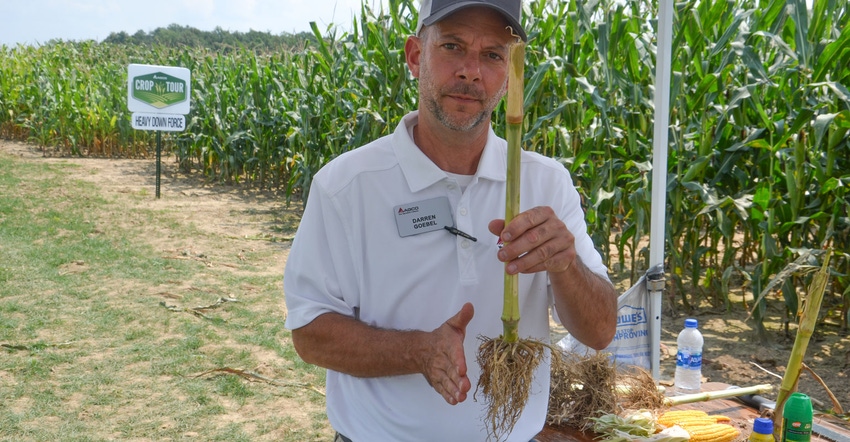September 20, 2018

Why isn’t every ear coming into the combine the same size? One reason may be that not every corn plant has the same size or same-shaped root system. Size and number of roots are somewhat controlled by genetics, but they can also be heavily impacted by the environment.
Darren Goebel says part of that environment is the amount of downforce or down pressure exerted on row units at planting time. Goebel is the director of global agronomy and farm solutions for Agco. He has helped supervise plots across the country over the past three years to show farmers how much difference planter adjustments can make during the rest of the season. One trial they’ve included in their plots compares different down-pressure systems.
One of their locations in 2018 was a farm near Union City, Ohio. It included a simple replicated downforce test. The field was planted with the farmer’s White planter. Three variations were compared: light, automatic control on average values of downforce and too much pressure. The planter was equipped with Precision Planting’s DeltaForce downforce control system. When set in automatic mode, it maintains the desired downforce on each row. Individual rows react independently of each other.
The “light” setting mimicked coil springs in the light setting on a row unit, Goebel says. Basically, there was no downforce on the units. The result were more skips than usual and uneven plant emergence. The automatic setting averaged about 100 pounds per square inch of downforce. The purposely heavy setting maintained 450 pounds of downforce on each row.
Predictable results
Yield estimates in mid-August were 156, 179 and 157 bushels per acre for the light, automatic and heavy settings, respectively, at the Ohio site, Goebel reports. The plots will go to yield. In the previous two years of comparisons, the automatic setting produced the best yields, followed by the heavy setting and then the light setting.
“Too light is much worse than too heavy,” Goebel says. His observations are that when downforce on units is too light, there just isn’t enough uniformity of depth placement, resulting in uneven emergence.
Too much pressure can produce what’s often known as “hatchet” roots. Young roots struggle getting out of the seed trench because of sidewall compaction. Roots grow down but don’t tend to grow out as wide on each side of the stalk as you would expect in a normal setting.
“I believe maintaining proper downforce on row units may be more important to yield than having proper seed singulation,” Goebel says. He realizes that’s a bold statement, since seed singulation has grabbed much more attention in the past. “Air bags alone instead of springs don’t solve your problem, because they can’t react. You need control of those row units.”
Goebel says the payoff for an investment in DeltaForce may be much faster than you think. His calculations indicate you could pay it off and reach breakeven planting around 750 acres of corn in one season with a 12-row planter, depending upon corn prices.
You May Also Like




